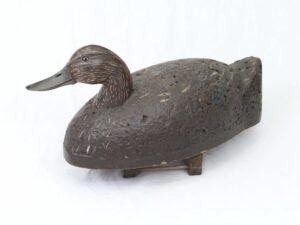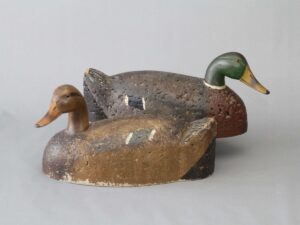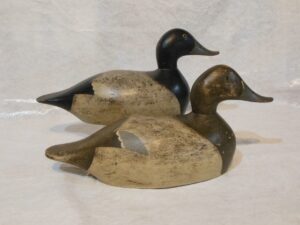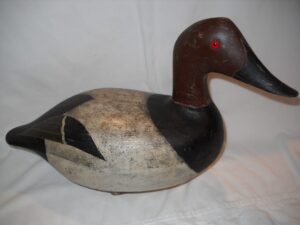A Decoy Corner Article
By Bruce Urben, WWA President
All photos courtesy Wisconsin Sporting Collectibles.

Ollie Drahn Blackduck
Oliver “Ollie” Drahn was born in Iowa in 1908 and migrated with his family to Oshkosh, WI, as a teenager, residing at 22 Union Street in Oshkosh. Ollie’s father taught him about hunting and fishing, and both were avid waterfowlers hunting the Winnebago Lakes area. Ollie’s waterfowling obsession brought him naturally to decoy carving in the 1930’s, during the Great Depression. Ollie was married in the middle 1930’s and worked as a mortician at the Fiss and Bill’s Funeral home in Oshkosh.
Considering that resources were scarce during the Depression, Drahn carved with whatever materials he found available, including old cedar fence posts, telephone poles and pine boards from old barns. The funeral business was very unpredictable and he had additional time on his hands, so he carved at the funeral home. It has been quoted that Ollie could carve efficiently with either hand and it seemed that he had a decoy head and Jack knife in his hand at most times.

Drahn Mallards
The heads on Ollie’s decoys are very realistic and display his artistic skills and talents. Most of his heads have bulbous cheeks with carved eye slots, extended bills with many necks cocked, turned or crouched – each one was different and one of a kind! His heads were attached to the body with a dowel, extending from just below the crown of the head and terminating through the bottom board or keel. The bills on his heads have carved mandibles, nostrils and a nail at the tip.
Ollie’s paint patterns were very well blended. It was known that one of his secrets to blending was the use of pipe cleaners and his wing patterns resembled the Walter Evans style. His painting was done with paint he obtained from his friend, Ray Parker, with whom he hunted. Mr. Parker designed a boat and decoy paint that dried to a dull finish. The Parker Paint Co. is still in business to this day in Green Bay, WI on Mason Street and still produces decoy painting kits that many carvers continue to use for their base paint. It has been reported that Ollie also used his mortician’s cosmetic “atomizer” in his decoy painting, maybe the first “airbrush”?

Drahn Bluebills
Ollie carved mainly canvasbacks and bluebills. Few black ducks and mallards were made by him as puddle duck hunting required less decoys than open water diver spreads on Lake Winnebago. He was a very precise carver as compared to a prolific one. He carved several hundred decoys in his lifetime for friends and local hunters even though he carved for 45 years!
In the mid 1940’s, Ollie transitioned to carving his decoys from cork rather than wood. He was able to obtain post-war cork from retired life rafts at a much lower cost. Later in his career he discontinued carving working decoys altogether and focused on decoratives. He became well known for his excellent decorative decoys.

Ollie Drahn Canvasback
Ollie Drahn passed away in 1988 in Oshkosh, just one week shy of his 81st birthday. Oliver “Ollie” Drahn was an artist, perfectionist, a man of great skill, patience and purpose. He was a true Wisconsin Original decoy carver.
While Ollie’s decoys are highly regarded and collected, they can still be found on the secondary market. Some are very pricey, but all are excellent examples of the Winnebago Lakes carvers. Any Wisconsin collector would be proud to own one. I wonder if my wife reads these articles, maybe a Drahn decoy is in my future.
